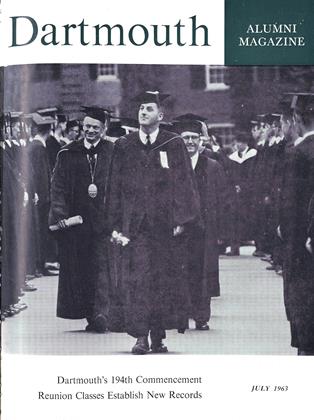By Harold Rugg '08.Foreword and editorial comments by Kenneth D. Benne. New York: Harper andRow, 1963. 361 pp. $6.95.
This posthumous publication of Dr. Harold Rugg's extensive research into the sources and conditions that stimulate creativity in man was made possible through the exceptionally fine editorial handiwork of Dr. Kenneth D. Benne. This work is very timely because during the past decade not only scholars but the public mind has been increasingly obsessed with identifying and developing the creative potential of the younger generations in our secondary schools, colleges, and universities. Furthermore, particularly in those fields involved in shaping the new social design for an industrial civilization, a wide variety of experimentation has been going forward.
Dr. Rugg's book. is quite different from earlier studies and seemingly more comprehensive in its nature. He has attempted a conceptual synthesis through an extensive multi-disciplinary search wherever it would throw new light on the mystery of creative imagination. His approach is definitely oriented to the scholar.
Imagination is divided into three parts, each of which might be read separately but which, when taken together, form a conceptual unity. The first part is concerned with the definition and description of the creative act in man. Here Dr. Rugg leads the reader on both a non-technical and a technical review in order to give clarity to the nature of creative thought.
Part II is largely, to quote from the editor's introduction, "a study of the ways by which men have thus sought to release their powers of imagination. In a sense, the arts and disciplines which these practices embody constitute technologies for inducing in themselves transliminal states."
In Part III, under the title "Toward a Theory of the Creative Imagination," Dr. Rugg sets up what he feels to be the conditions of an adequate theory, how it may be approached, its imperatives, together with possible applications to educational theory.
 View Full Issue
View Full Issue
More From This Issue
-
 Feature
FeatureThe Second Emancipation
July 1963 By THE REV. JAMES H. ROBINSON, D.D. '63 -
 Feature
FeatureHONORARY DEGREE CITATIONS
July 1963 -
 Feature
FeatureThe Alumni Council's 50th Year
July 1963 -
 Feature
FeatureThe Past Is Prologue
July 1963 By T. DONALD CUNNINGHAM '13 -
 Feature
FeatureA Record-Breaking Reunion Week
July 1963 -
 Feature
FeatureThe Honesty That Is Dartmouth
July 1963 By ALAN KENNETH PALMER '63










